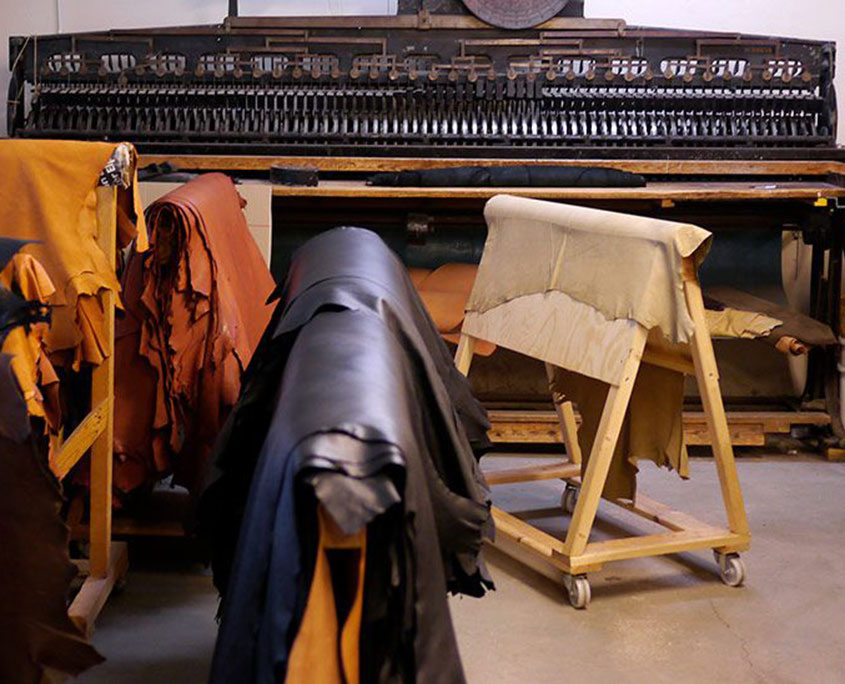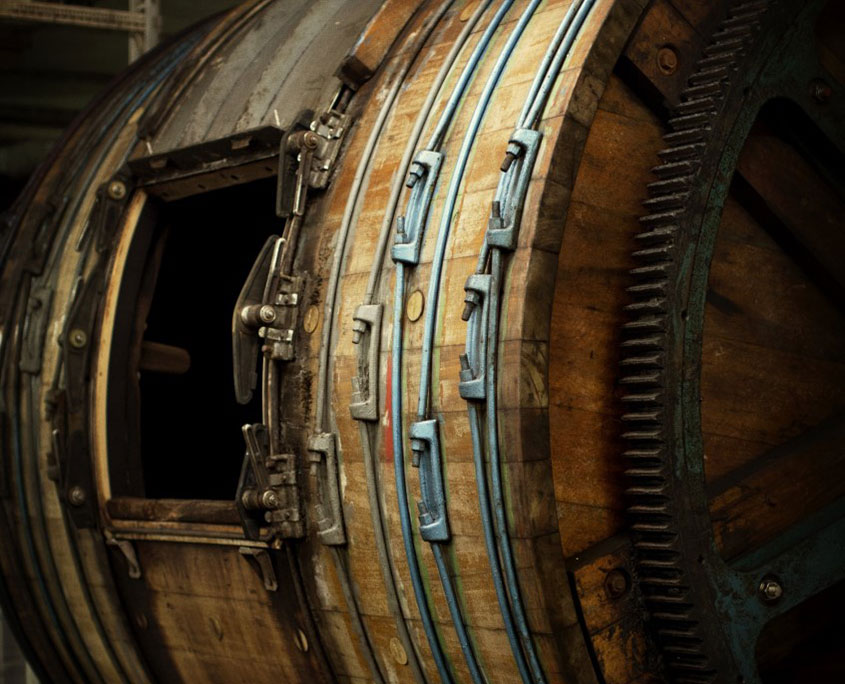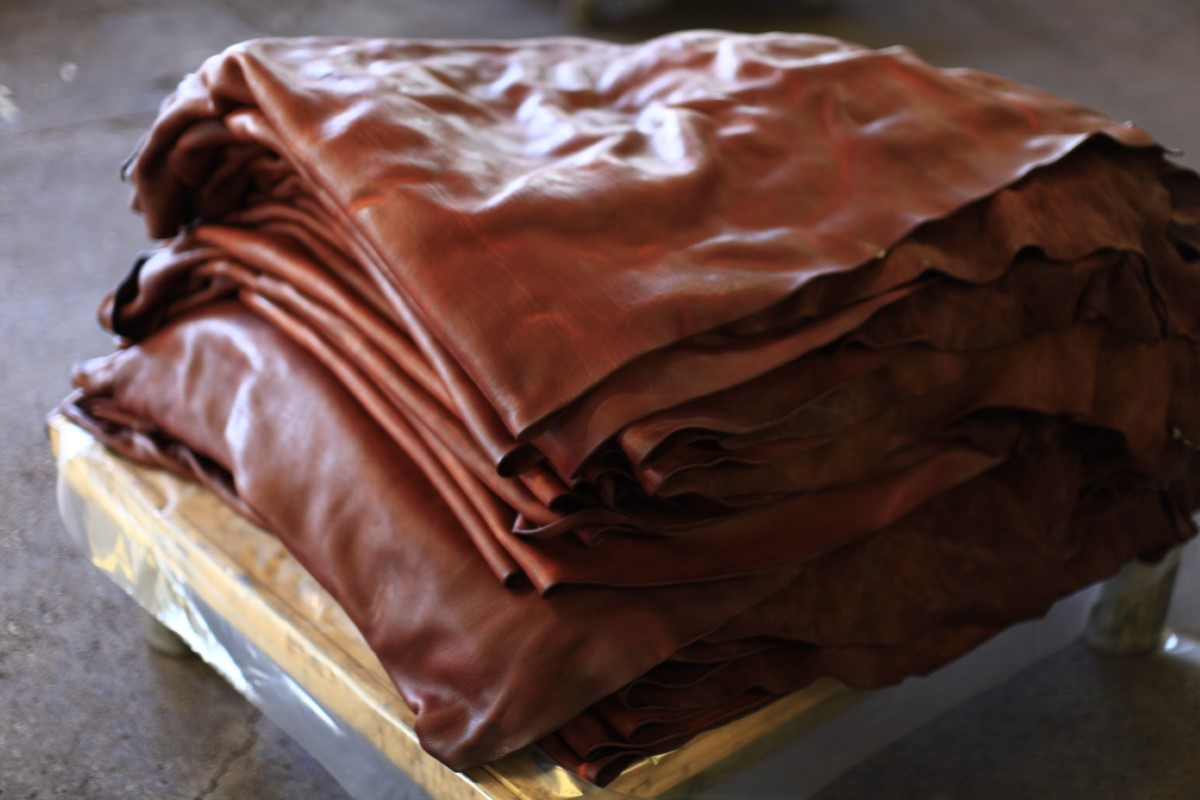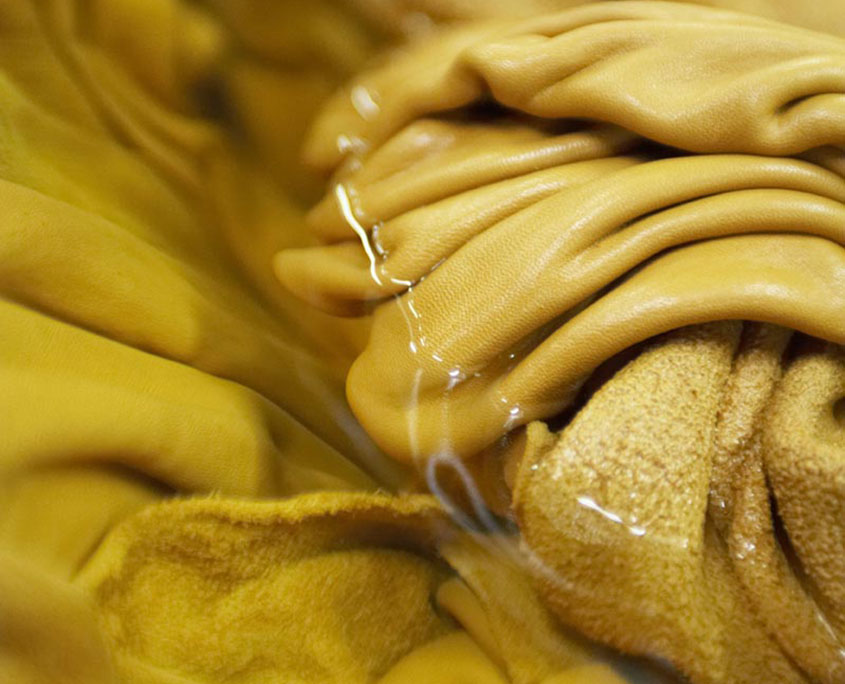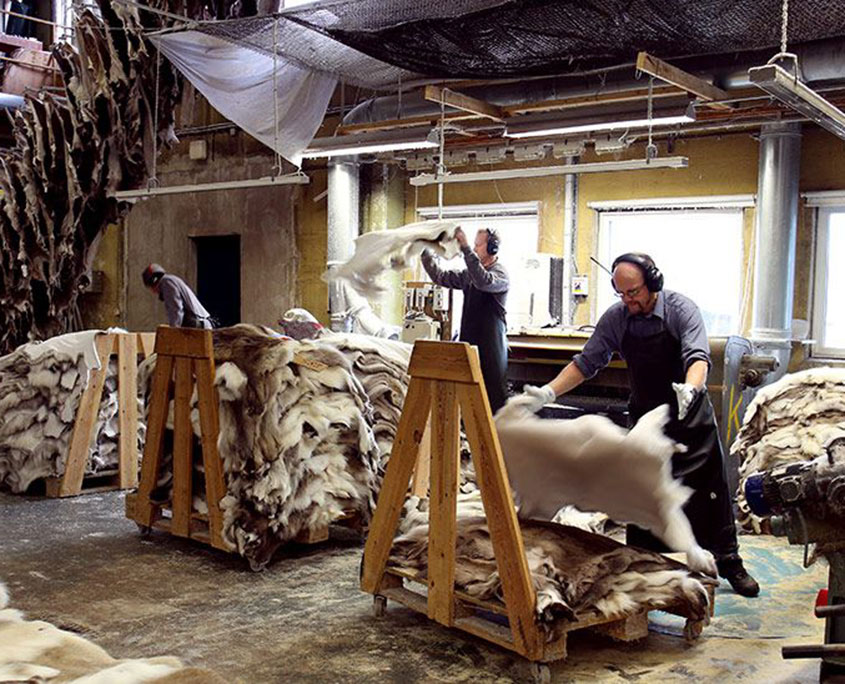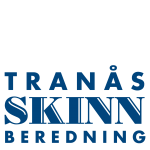Varför välja läder tillverkat i Sverige?
Läder är tåligt, slitstarkt, funktionellt och komfortabelt - och vackert enligt vår uppfattning. Läder som tillverkas under korrekta betingelser bidrar till ett hållbart samhälle. Råvaran i svenska garverier är hudar och skinn från nötkreatur samt får och renar och som alla föds upp för att förse oss med livsmedel, dvs. kött och mjölkprodukter. Företagen tar därmed tillvara en restprodukt och förädlar den till ett material med lång livslängd. Läder är inte en slit- och slängprodukt!
Svenskt läder är en restprodukt
Råvaran i svenska garverier är hudar och skinn från nötkreatur samt får och renar och som alla föds upp för att förse oss med livsmedel, dvs. kött och mjölkprodukter.
Läder och djurskydd går hand i hand
Tillverkning av högkvalitativt läder möjliggör garveriernas påverkan för ett fullgott djurskydd. Det finns spårbarhetssystem som gör det möjligt för läderindustrin att föra en dialog med jordbruket om denna viktiga fråga.
Hög hantverksskicklighet
Det fordras manuella insatser och kunskaper för att ständigt bedöma och hantera varje hud eller skinn. Goda kunskaper och mångårig vana hos de anställda är ett av de svenska garveriernas främsta konkurrensmedel.
Biologiskt nedbrytbart
Istället för att hudar och skinn går till förbränning, vilket inte är ett hållbart tillvägagångssätt, förädlar garverier dem till ett biologiskt nedbrytbart material som erbjuder konsumenterna komfort och skönhet.
Frågor & Svar
Finns det många garverier i Sverige?
Garveriindustrin är en liten industri i Sverige och idag finns det endast fyra garverier/berederier som arbetar i industriell skala. De olika företagen har specialiserat sig på olika nischer inom läder och skinnproduktion och konkurrerar därför inte med varandra.
I Sverige finns Elmo Sweden som primärt fokuserar på att tillverka läder till möbler och bilinteriörer, Tärnsjö Garveri som specialiserat sig på tillverkning av vegetabiliskt läder, Kero Leather som primärt arbetar med renskinn som är en unik råvara och slutligen Tranås Skinnberedning som bereder fårskinn.
Hur har garveriindustrin utvecklats i Sverige under de senaste åren?
Den svenska garveriindustrin var stor i slutet på 1800-talet och början på 1900-talet. Vid denna tid utvecklades garverierna från att vara hantverk till industrier vilket ledde till att antalet garverier minskade. Trots detta fanns det mer än 100 garverier i Sverige i början på 1900-talet.
Den stora nedgången för garveriindustrin inträffade efter andra världskriget och berodde på flera faktorer. En bidragande orsak var att den svenska skoindustrin kom i kris och flera betydande skofabriker som använt svenskt läder lades ned. Ytterligare anledningar till branschens nedgång är att högre miljökrav ställdes på industrin. Samtidigt ökade arbetskostnaderna väsentligt medan en stor del av läderimporten kom som lågprisläder från länder i Asien.
Däremot har garverierna i Sverige klarat sig relativt bra under de senaste 20 åren och antalet garverier har varit oförändrat trots att några företag har omstrukturerats under denna tid.
Hur ser framtiden ut för de svenska garverierna?
Framtiden ser ljus ut för de svenska garverierna eftersom de garverier som idag producerar läder och skinn har hittat sin speciella nisch och är konkurrenskraftiga internationellt med mycket hög kvalitet på produkterna.
Samarbetar de svenska garverierna exempelvis i miljöfrågor?
De svenska garverierna samarbetar tillsammans med de övriga nordiska garverierna i miljöfrågor. Detta betyder att de nordiska garverierna oftast kommenterar nya lagförslag inom EU under remisstiden, man håller sig uppdaterad om nya initiativ på miljöområdet som berör garverier samt utbyter erfarenheter genom ett intensivt nätverksarbete.
Var i världen finns de flesta garverierna?
Idag tillverkas merparten av allt läder i Asien och Kina är den största producenten av läder. I Europa är garveriindustrin fortfarande mycket betydelsefull. Italien står för cirka 60% av den europeiska produktionen. Italien är också fortfarande den tredje största producenten av läder i världen.
Hur är de svenska garverierna miljömässigt jämfört med garverier i andra länder?
De svenska garverierna ligger i framkanten i världen när det gäller miljöarbete och nämns ofta som ett bra exempel internationellt. Anledningen till detta är dels miljölagstiftningen i Sverige men även att de svenska garverierna har valt att satsa på miljövänliga alternativ i produktionen.
Hur regleras garverierna i Sverige miljömässigt?
De svenska garverierna regleras genom den så kallade miljöprövnings-förordningen. Detta betyder att garverierna beroende på storlek antingen är tillståndspliktiga eller anmälningspliktiga. Oavsett vilket måste garverierna leva upp till de miljövillkor som myndigheterna har bestämt och som en tumregel blir kraven högre och mer detaljerade ju större garverierna är. Det är i Sverige vanligtvis länsstyrelsen som kontrollerar att kraven uppfylls. Vidare följer de svenska garverierna även krav i förordningar från EU som exempelvis kemikalielagstiftningen i REACH.
Man ska vara uppmärksam på att det är enbart företag med produktion i Sverige som får svenska miljökrav och även regelbundna inspektioner från myndigheterna. Det är således inte korrekt att företag med produktion utanför Sverige kan leva upp till svenska miljökrav eftersom de inte har svenska miljökrav (som kan variera beroende på lokala förhållanden) och vidare har de inga inspektioner från svenska myndigheter.
Slaktas djur för att man ska tillverka läder?
Nej, hudar och skinn är en biprodukt till köttindustrin och tillgången på hudar och skinn bestäms av köttproduktionen. Värdet på hudar och skinn motsvarar enbart en mycket liten del (ofta 1 – 3%) av hela djurets värde och har under senare år minskat ytterligare.
Det finns nya vetenskapliga undersökningar från USA som publicerades 2021. Undersökningen som baseras på data från 1995 – 2019 visar att antalet djur som slaktas inte påverkas av priset på hudarna dvs. det slaktas inte fler djur om priserna för hudar ökar.
Efterfrågan på läder har under senare år minskat medan köttätandet globalt inte minskat. Detta har lett till att i exempelvis USA och Australien har man varit tvungen att kasta (deponera) hudar istället för att tillverka läder. Under 2019 deponerades 5,5 miljoner hudar i USA och under 2020 deponerades 4,8 miljoner hudar istället för att tillverka läder från detta material. Läder har istället ofta ersatts av olika plastmaterial som är oljebaserade material. Man kunde under 2020 ha tillverkat läder från hudar som deponerades i USA till att tillverka 86,4 miljoner skor eller 1,6 miljoner soffor istället för att slänga (deponera) hudarna.
Är djurskydd viktigt för garverier?
Djurens välmående är viktigt för garverier även om det inte alltid är så lätt att påverka slakterier och lantbrukare om detta. Hudarnas/skinnens kvalitet blir bättre om djuren har ett bra liv medan stress hos djuren påverkar hudarnas kvalitet negativt. Därmed blir också kvaliteten på läder som produceras sämre.
Man arbetar idag mer och mer på att ha en spårbarhet av de hudar som används vid lädertillverkning så att konsumenten kan få informationen varifrån hudarna kommer även ned till vilket lantbruk som djuret växt upp på. Detta kommer göra det lättare för konsumenter att vara säkra på att djuren behandlats bra under sin levnadstid.
Är garvning av hudar och skinn en förorenande industri?
Man kan säga att garvning är en potentiellt förorenande industri och i många delar av världen orsakar garverierna stora miljöproblem (exempelvis i Bangladesh).
Det har dock utvecklats miljövänliga teknologier att tillverka läder där miljöbelastningen har minskat väsentligt. Det kommer dock alltid att finnas kvar en miljöbelastning från garverier och man har därför utvecklat moderna och effektiva metoder för att behandla avloppsvattnet och ta tillvara på de avfallsprodukter som bildas.
Det kan exempelvis nämnas att avfall från garverier i Sverige bland annat används till att producera biogas med bra resultat och till att producera gelatin som används vid godistillverkning.
Siffror på hur mycket miljöbelastningen kan minska genom användning av miljövänliga alternativ kan erhållas via Svenska Garveriidkarföreningen.
Vad händer med garveriernas avloppsvatten?
Garverier liksom de flesta industrier använder vatten i sina processer och efter processerna blir vattnet till avloppsvatten som måste renas innan det släpps ut till recipienten.
De svenska garverierna använder olika strategier men det gemensamma för dem är att vattnet renas enligt de stränga miljökrav som finns i Sverige. Två garverier har sina egna reningsverk som behandlar vattnet innan det leds ut till recipienten. Ett garveri gör en för-rening på garveriet innan vattnet renas i det kommunala reningsverket medan det fjärde garveriet leder sitt vatten till det kommunala reningsverket. De kommunala reningsverken som tar emot vatten från garverier i Sverige är byggda för att rena vattnet från garverier och garverierna betalar självfallet för den extra kostnad som reningsverket har att rena vattnet.
Använder man farliga kemikalier vid lädertillverkning?
Garverier använder många olika kemikalier i samband med lädertillverkning. De svenska garverierna följer den europeiska kemikalielagstiftningen som kallas REACH. Detta betyder att kemikalier som kan vara farliga antingen för hälsa (både för arbetare och konsumenter) eller miljö har ersatts av andra mindre skadliga kemikalier.
Det sker hela tiden en utveckling avseende kemikalier och ny kunskap kan visa att kemikalier som tidigare ansågs miljövänliga i vissa fall kan ha negativa effekter på miljö eller hälsa. De svenska garverierna följer därför noggrant med den tekniska utvecklingen och om vetenskapliga studier indikerar att en kemikalie som används kan ha negativa effekter startas ett omfattande utvecklingsarbete tillsammans med kemikalieleverantörer för att hitta ett bättre alternativ. Detta betyder de svenska garverierna hela tiden försöker ligga före i utvecklingen och ersätta problematiska kemikalier med säkrare alternativ innan kemikalierna förbjuds.
Använder man arsenik, kadmium eller hexavalent krom vid lädertillverkning?
Nej, ingen av ovanstående kemikalier används vid garvning i Sverige. Det är ibland man ser dessa kemikalier nämnas i samband med läder och läderproduktion och vi ska nedan kort beskriva varför.
Arsenikdisulfid användes för många år sedan i samband med avhårning av hudar. Kemikalien har inte använts på väldigt många år i garveriindustrin. Idag används exempelvis natriumsulfid istället.
Mindre mängder kadmium kunde tidigare finnas i vissa färgpigment (gul färg) men är sedan länge ersatta av andra färgpigment vid lädertillverkning.
Hexavalent (sexvärt) krom som är allergiframkallande och även kan ge lungcancer vid inandning används inte vid garvning. Den absolut vanligaste garvningsmetoden i världen är garvning med trevärt krom som är en annan kemisk form av krom med helt andra egenskaper än sexvärt krom.
Det har visat sig att små mängder av trevärt krom kan omvandlas till sexvärt krom i läder under vissa förhållanden. Detta är dock välkänt av garveriindustrin och man har kunskap om varför detta sker och hur man kan undvika att sexvärt krom bildas. De svenska garverierna följer dessa riktlinjer noggrant och hexavalent krom finns därför inte i läder som producerats i Sverige. Däremot kan sexvärt krom i några tillfällen upptäckas i importerat läder där processkontrollen inte varit tillräcklig. Det är inte tillåtet att sälja läder som innehåller sexvärt krom inom EU och svenska myndigheter som exempelvis kemikalieinspektionen kontrollerar ofta detta genom att analysera läderprodukter på marknaden.
Vad är egentligen läder?
Läder är ett unikt material som kommer från hudar och skinn som garvats. Det finns till och med en europeisk standard (EN 15987) som klart definierar vad läder är.
Dessvärre finns det en del tillverkare av andra alternativa material till läder som felaktigt kallar sitt material för läder eftersom många konsumenter förknippar läder med bra kvalitet. Exempel på detta är veganläder, ananasläder och äppelläder.
Garveriindustrin har inget emot att alternativa material utvecklas men anser att det är viktigt att konsumenten får veta vad det är för material. Exempelvis kan nämnas att veganläder ofta är plastmaterial och enligt vår uppfattning är det viktigt att konsumenten får denna information.
Ibland påstås att vegetabil garvning är kemikaliefri – stämmer det?
Nej, det är inte korrekt. Lädertillverkning består av ett flertal processer och alla garverier oavsett garvningsmetod använder kemikalier exempelvis i samband med avhårning, färgning och fettning av läder.
Även om vi enbart tittar på själva garvningsprocessen är påståendet inte korrekt. Vegetabila garvämnen består av extrakt från bark, trä eller plantor men även dessa extrakt består ju av kemikalier.
Vad används läder till?
Läder har många användningsområden. Det största användningsområdet för läder idag är till skor och ungefär hälften (50 %) av allt läder som produceras i världen används till skoframställning. Användningen av läder till skor har dock visat på en nedgång under senare år och läder har upplevt en stor konkurrens från alternativa material. Vidare används cirka 20 % av allt läder till beklädnadsindustrin.
Möbel- och bilindustrin är stora användare av läder och strax under 20% av allt läder används till möbelläder och billäder. Framförallt billäder har under de senaste 10 åren visat på en uppgång.
Vidare används cirka 15 – 20 % av allt läder till andra användningsområden inklusive handskar, handväskor, remmar, sadlar med mera.
Vad är ”veganmaterial”?
Beteckningen ”veganläder” är egentligen felaktig eftersom det enligt internationell standard inte är läder. Begreppet används ofta för material som ska imitera läder men som är tillverkade utan animaliska produkter. Materialet består oftast av PU (polyuretan) och är således en plastprodukt. Detta nämns oftast inte utan man försöker få materialet att framstå som ett miljövänligt alternativ till läder och samtidigt dra nytta av läders goda rykte som ett material med hög kvalitet.
Det finns även ett antal material på marknaden som delvis baseras på naturliga material (exempelvis ananasläder och äppelläder). Oftast består dessa material av två plastskikt där man inkluderat det naturliga materialet mellan dessa plastlager.
En vetenskaplig undersökning från Tyskland av ett flertal av dessa material publicerades i början av 2021. Undersökningen visade att läder var det material med de bästa egenskaperna (man undersökte egenskaper som är relevanta för skotillverkning). Det fanns alternativa material som hade bra egenskaper på vissa tester men därefter inte kunde konkurrera med läder på andra tester. Vidare hittade man miljöfarliga ämnen som ftalater i flera av de alternativa materialen till läder. En kopia av den vetenskapliga rapporten kan erhållas från Svenska Garveriidkarföreningen.
Garvning
Numera tillämpas i huvudsak tre olika garvningsmetoder; kromgarvning, vegetabilisk garvning och kromfri garvning. Ur ett livscykelperspektiv har flera undersökningar visat att de tre garvningsmetoderna är i stort sett lika då alla tre i viss mån belastar miljön och kräver olika insatser. Vill du veta mer om hur tillverkningen av läder samt får- och skinnfällar går till i Sverige, läs mer hos våra medlemsföretag.
KROMGRAVNING
Kromgarvning är den vanligaste metoden globalt och används vid cirka 75 % av all lädertillverkning. Metoden bygger på användning av trevärt krom (krom III), ett säkert ämne som också förekommer i kosttillskott. Trots att det ibland påstås, används inte sexvärt krom (krom VI) i läderindustrin. I Sverige följer garverierna noggrant de riktlinjer som säkerställer att krom VI inte uppstår under processen. Kromgarvat läder är mycket slitstarkt och behåller sina egenskaper under lång tid.
VEGETABIL GARVNING
Vegetabilisk garvning är den äldsta kända metoden för att konservera hudar. Här används garvämnen från växtriket, till exempel tanniner från bark, blad eller frukter. Lädret får en naturlig och levande karaktär som förändras och utvecklas med tiden. Det är särskilt uppskattat inom traditionellt hantverk och för produkter där en naturlig estetik är viktig.
KROMFRI GARVNING
Kromfri garvning omfattar flera metoder där inget krom används i processen. Den vanligaste är aldehydgarvning, där glutaraldehyd fungerar som garvämne. Ofta kombineras denna metod med andra syntetiska ämnen för att uppnå önskad kvalitet. Kromfritt garvat läder har andra egenskaper än kromgarvat, och används ofta när särskilda krav på allergivänlighet eller miljöprofil finns.
Garvning i Sverige
I Sverige finns idag fyra garverier som fortfarande bedriver traditionell garvning – alla med ett starkt fokus på hållbarhet, kvalitet och hantverk. Processerna är miljöanpassade och bygger på en kombination av lång erfarenhet och modern teknik. Varje steg i processen – från råhud till färdigt läder eller fäll – präglas av kunskap, omsorg och respekt för naturen. Vill du veta mer om hur tillverkningen av läder samt får- och skinnfällar går till i Sverige, läs mer hos våra medlemsföretag.
Tranås Skinnberedning
Läs om beredningsprocessen på Tranås Skinnberedning.
Hållbarhet och miljö
Som en del av Sveriges tillverkningsindustri arbetar svenska garverier i enlighet med gällande lagar och direktiv som gäller inom EU och Sverige. Läder och får- och renskinnsfällar som tillverkas i Sverige motsvarar EUs och Sveriges krav på hållbarhet och miljö.
Läder är unikt ur materialsynpunkt och erbjuder en mängd olika användningsområden. De svenska garverierna levererar läder för bland annat skor, väskor, plånböcker, möbler, interiörer i bilar, tåg och flygplan samt ren- och fårskinnsfällar.
4 st
I början 1900-talet fanns över 130 garverier, spridda över landet. Idag finns det endast 4 st kvar.
100%
av hudarna och skinnen kommer från nötkreatur, får och renar som fötts upp i Skandinavien.
Detta inlägg finns också tillgängligt i: Engelska





